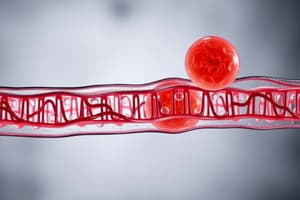Podcast
Questions and Answers
What is the main distinction between phagocytosis and pinocytosis in the process of endocytosis?
What is the main distinction between phagocytosis and pinocytosis in the process of endocytosis?
- Phagocytosis occurs only in immune cells, while pinocytosis can happen in any cell type.
- Phagocytosis is a method for engulfing solid particles, whereas pinocytosis is for fluid droplets. (correct)
- Phagocytosis involves fluid droplets while pinocytosis involves solid particles.
- Phagocytosis requires specific receptor recognition while pinocytosis does not.
What is the role of receptor-mediated endocytosis?
What is the role of receptor-mediated endocytosis?
- To stabilize the cell membrane by absorbing extracellular fluid.
- To engulf large particles using membrane extensions known as pseudopodia.
- To secrete cellular waste products through vesicle fusion.
- To selectively internalize specific substances through binding with receptor proteins. (correct)
What is the primary function of exocytosis in cellular activities?
What is the primary function of exocytosis in cellular activities?
- To maintain cellular shape by recycling membrane components.
- To synthesize proteins within the nucleus before releasing them into the cytoplasm.
- To transport substances into the cell by encapsulating them within a vesicle.
- To actively secrete substances such as hormones and mucus out of the cell. (correct)
Which of the following statements regarding the cell coat is accurate?
Which of the following statements regarding the cell coat is accurate?
What happens to the vesicle formed during endocytosis after it detaches from the plasma membrane?
What happens to the vesicle formed during endocytosis after it detaches from the plasma membrane?
What characteristic distinguishes integral proteins from peripheral proteins in the cell membrane?
What characteristic distinguishes integral proteins from peripheral proteins in the cell membrane?
Which component of the cell membrane is primarily responsible for the formation of a barrier to hydrophilic substances?
Which component of the cell membrane is primarily responsible for the formation of a barrier to hydrophilic substances?
What role do glycolipids and glycoproteins serve on the cell membrane's outer surface?
What role do glycolipids and glycoproteins serve on the cell membrane's outer surface?
In facilitated diffusion, what is the primary function of a carrier protein?
In facilitated diffusion, what is the primary function of a carrier protein?
Which transport mechanism requires energy to move substances across the membrane?
Which transport mechanism requires energy to move substances across the membrane?
What is the primary function of the cholesterol molecules within the phospholipid bilayer?
What is the primary function of the cholesterol molecules within the phospholipid bilayer?
How does the electron microscope visualize the cell membrane?
How does the electron microscope visualize the cell membrane?
What process involves the formation of vesicles to transport large molecules into or out of the cell?
What process involves the formation of vesicles to transport large molecules into or out of the cell?
Which of the following statements about cytoplasmic organelles is accurate?
Which of the following statements about cytoplasmic organelles is accurate?
What is a key distinction between living and non-living cytoplasmic inclusions?
What is a key distinction between living and non-living cytoplasmic inclusions?
Which organelle is categorized as a non-membranous organelle?
Which organelle is categorized as a non-membranous organelle?
Which of the following best describes the role of the cell membrane?
Which of the following best describes the role of the cell membrane?
What is the approximate size range of a typical cell?
What is the approximate size range of a typical cell?
Which feature is common to membranous organelles?
Which feature is common to membranous organelles?
Which statement about organelles is true?
Which statement about organelles is true?
What type of organelles are peroxisomes classified as?
What type of organelles are peroxisomes classified as?
Flashcards are hidden until you start studying
Study Notes
Structure of the Cell
- Cells are the fundamental structural and functional units of life.
- Size varies from 4 to 150 micrometers (µm).
- Shapes include rounded, oval, flat, cubical, columnar, and polygonal.
- Functions encompass secretion, absorption, sensation, and contraction.
Components of the Cell
- Composed of cytoplasm, nucleus, organelles, and inclusions.
Cytoplasmic Organelles
- Living Organelles: Permanent structures crucial for cell function, metabolically active (e.g., mitochondria, endoplasmic reticulum).
- Non-living Inclusions: Transient components not essential for cell survival, metabolically inert (e.g., carbohydrates, pigments, lipids).
Types of Cytoplasmic Organelles
- Membranous Organelles: Enclosed by membranes and contain enzymes (e.g., mitochondria, lysosomes, Golgi apparatus).
- Non-membranous Organelles: Lack membranes and do not contain enzymes (e.g., ribosomes, cytoskeleton, proteasomes).
Cell Membrane
- The outermost layer defining the cell's boundary, separating cytoplasm from extracellular fluid.
- Visible via light microscopy (special stains only) and electron microscopy (trilamellar structure).
Molecular Structure of Cell Membrane
- Lipid Component:
- Composed mainly of a phospholipid bilayer with hydrophilic heads outward and hydrophobic tails inward.
- Cholesterol molecules interspersed within bilayer.
- Protein Component:
- Integral proteins span entire membrane; peripheral proteins located on membrane surfaces.
- Carbohydrate Component:
- Found exclusively on the extracellular surface, forming glycoproteins and glycolipids.
Glycocalyx
- Formed by glycoproteins and glycolipids on the cell membrane's outer surface.
- Appears fuzzy under electron microscopy and serves multiple functions.
Functions of the Cell Membrane
- Transport Mechanisms:
- Passive diffusion allows unassisted movement of small molecules along their concentration gradient.
- Facilitated diffusion employs carrier proteins for assisted transport of small molecules and ions.
- Active transport refers to movement against the concentration gradient, as seen in the Na/K pump.
- Bulk (vesicular) transport includes endocytosis and exocytosis for large molecule transport.
Endocytosis
- Involves engulfing extracellular substances within membrane-bound vesicles.
- Three forms:
- Phagocytosis: Engulfing solid particles (e.g., bacteria).
- Pinocytosis: Engulfing fluid droplets (e.g., dissolved proteins).
- Receptor-mediated endocytosis: Selective process requiring specific binding to receptors.
Exocytosis
- The process by which substances are expelled from the cell.
- Involves packaging products into vesicles that fuse with the membrane, releasing contents outside the cell.
Functions of the Cell Coat (Glycocalyx)
- Provides protection and stability to the cell.
- Facilitates cell identity through recognition processes involving glycoproteins and glycolipids.
- Aids in cell-cell interactions and acts as receptors for specific pathogens.
Studying That Suits You
Use AI to generate personalized quizzes and flashcards to suit your learning preferences.




